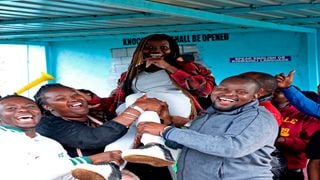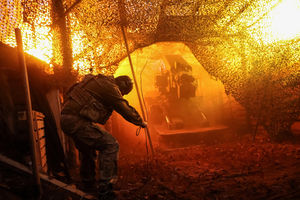
Parents, teachers and student of Mary Immaculate Education Center in Nairobi celebrate Elizabeth Wairimu Mugo who scored 407 Marks in the 2023 KCPE examination in this photo taken on November 23, 2023.
| Lucy Wanjiru | Nation Media GroupEducation
Premium
How Form One slots will be shared
What you need to know:
- 8,523 candidates scored 400 marks and above, but national schools only have a capacity of 5,570 learners.
- Ministry of Education has developed a placement system that will ensure national, regional and socio-economic balance.
The scramble for vacancies in secondary schools begins tomorrow when the Ministry of Education starts the placement exercise for candidates who sat the last Kenya Certificate of Primary Education (KCPE) examinations.
A total of 1,406,577 candidates sat the examination and received their results on Thursday. Focus now shifts to the schools they will be placed in, with candidates and their families eyeing institutions with a history of good performance in national examinations. The top performers are hopeful of selection to join prestigious national schools as well as extra-county schools.
Education Cabinet Secretary Ezekiel Machogu said the placement will last two weeks and that candidates and their families will have the results before Christmas. The exercise is fully computerised based on the choices that candidates made. The Ministry of Education does not place overage candidates or non-citizens.
“Already, the ministry has developed a fair and transparent system for Form One placement that will ensure national, regional and socio-economic balance is achieved,” Mr Machogu said on Friday, adding that all candidates who sat for the exams will have an opportunity to transition to secondary school.
It is also a unique year since no pupil can repeat the primary school examinations with the 2023 KCPE being the last. However, those who were in Standard Eight but failed to sit the exam will have another chance by sitting a special test in January.
Historically, candidates who score 400 marks and above get selected to national schools. There were 8,523 candidates who attained and surpassed the mark this year. National schools have a capacity of 5,570 learners. At least 352,782 other candidates scored between 300 and 399 marks while those ranging between 200 and 299 marks were the majority (658,278).
Over the years, some established national schools like Nanyuki High School, Pangani Girls, Mang’u High, Alliance Girlsand Alliance High School have attracted huge number of applicants.
The selection is based on learner choices, overall performance, individual performance, affirmative action type of school they attended (whether public or private). Private schools have often protested bias against their candidates in the selection process.
During selection, choices for schools, learners and parents are known to shun national schools that were recently upgraded. Candidates are required to make four choices of national schools and three of extra-county schools. They are then supposed to select two county and two sub-county institutions which accommodate more than 70 percent of the candidates.
Thereafter, candidates access and download admission letters from the Ministry of Education portal. The Form Ones will report after the continuing students, but this is expected within the month of January 2024.
Also Read: Kenyans prefer CBC to 8-4-4, study shows
All learners in public secondary schools qualify for sponsorship through the Free Day Secondary Education programme at Sh22,244.
Michael Warutere, who topped the examinations nationally with a score of 428 marks out of a possible 500, says he wants to join Mang’u High, one of the oldest schools in Kenya known for producing some of Kenya’s most prominent personalities across various fields. Michael was a learner at Riara Springs Academy, Nairobi.
His classmate Peter Kiringa Ruku scored 424 marks and had selected Alliance High School as his first choice. The Sunday Nation was unable to reach him as after the celebrations, he went into a camp for boys’ rites of passage dubbed “Beyond the Cut’. His father, Mbeere North MP Geoffrey Ruku, told Sunday Nation that the family will soon make a decision on Peter’s transition to high school.
“He wanted Alliance but now he’s talking of Strathmore. I’m still thinking and there are many things to consider. Some people are also advising that I take him to an international curriculum, but I think for one to fit into Kenya’s economy, they need a local education,” he said.





